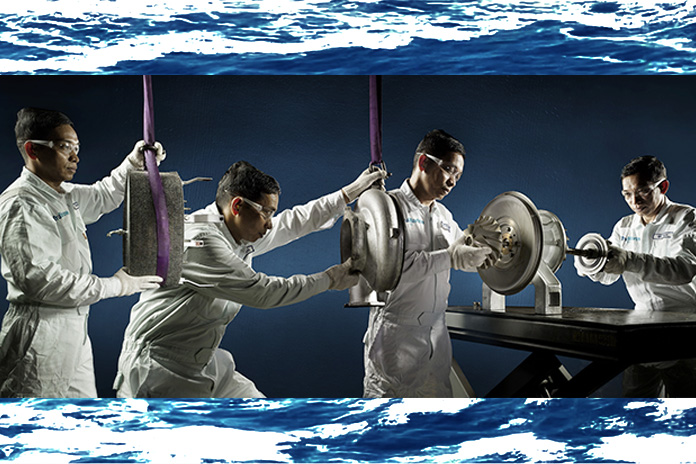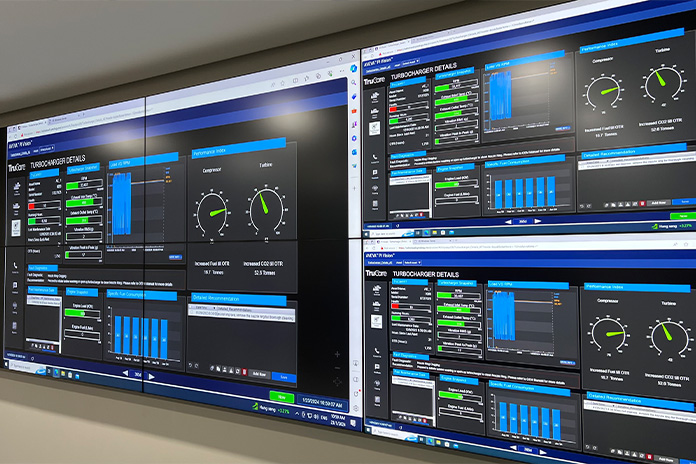
MANY see AI as a threat to blue-collar workers, and more recently generative AI seems to be worrying those in creative disciplines. While the long-term threat of replacement lingers, in the short and medium terms such tools will enable businesses to get an edge over their competition both financially and in terms of physical productivity.
Many businesses are utilising AI for predictive maintenance, enabling them to cut costs by avoiding under or over maintenance, or replacement of physical hardware.
AI can pop up in a variety of places. To showcase its versatility, we look at how Tru-Marine, a Singaporean company with decades of experience in turbocharger maintenance, has adopted AI to expand its business.
Turbochargers with their fast-spinning turbines can be found in all diesel engines, pumping in additional air to infuse the fuel with more atmosphere, enabling more efficient combustion. The average vessel has four to six turbochargers, while cruise liners may have up to eight.
Located in Tuas, the Tru-Marine facility houses a variety of departments that range from repairing to fabricating and innovating.
AI In Practice
Tru-Marine has recently developed TruCare, a predictive maintenance application that tracks the status of deployed turbochargers and collects data related to wear and tear or unexpected damage that will help it anticipate future repairs. It can also provide a good estimation of fuel savings.
“TruCare is a very big innovation that has been done in-house,” explains James Loke, Group CEO of Tru-Marine.
“Together with A*STAR. The difficult parts for the team were developing the machine learning and algorithm,” Loke adds.

While weathered sea captains may swear their intimate understanding of their ships’ engines exceeds the performance of any algorithm, trusting their instincts may not be wise when your company’s bottom line is at stake.
Instead, Internet of Things (IoT) sensors monitor turbochargers for excessive vibrations as they spin, data is also collected from screens onboard the cargo vessels that monitor engine status. This minimal intervention approach enables turbocharger-related data collection without breaching the ship owner’s data privacy, an issue that will be of greater concern in an AI populated world.
Information from these sensors is observed from the turbocharger monitoring station at Tru-Marine’s Tuas base, the command centre of their AI frontier.
While tracking remains experimental, only having been rolled out across a small number of ships, this preparation will enable the onboarding of the many thousands of ships that rely on their turbocharger maintenance services.
With branches in China, Dubai, Rotterdam, Indonesia, Japan and Korea, Tru-Marine’s influence has the potential to span a much wider area of the globe.
The local SME is currently assessing how their predictive maintenance technology can be applied to other cargo ship components and are currently in discussion with partners across the supply chain, as they look to maximise the utility of their tech investment.
Automation And Its Challenges
Singapore’s dynamic port environment will see the port services completing its shift north towards Tuas in the 2040s. The new automated, intelligent and sustainable facility will have 66 berths spanning 26km, with a handling capacity of 65 million TEUs (20-foot equivalent units), double of what it handled in 2021.
This will allow for more interactions with the industrial districts in Jurong and Tuas.
While that may seem ideal for Tru-Marine in terms of location, Loke notes that the automation of cargo vessel inspections at Singapore’s Tuas port has put pressure on the turnaround time for turbocharger repairs. Mobile technology now enables ICA officers to clear cargo on the fly, reducing time spent by drivers waiting for cargo image scans by up to 17 minutes.
Businesses such as Tru-Marine will need to anticipate future demand from such innovation and develop quicker response mechanisms to stay relevant.
Predictive maintenance will be essential in enabling the company to adapt to changes in the speed of commerce due to automation, minimising unnecessary maintenance and hence overcrowding of their repairs station in Singapore.

Anticipating Business Needs
Despite not being a turbocharger manufacturer, Tru-Marine has put extensive research into printing their own parts, either from scratch or printing materials to assist in repairs. Printed parts have the same durability and performance standards as those from their suppliers and can be achieved without having to wait for parts to be brought in.
Additive manufacturing techniques such as 3D printing enable the creation of a circular economy, where goods can be manufactured locally as they are needed, cutting down on the carbon footprint of global transportation, relieving inventory storage costs, minimising the need for bulk production, and generally reducing pressure on global supply chains.
For Tru-Marine, the addition of 3D printing to their arsenal may enable them to service cargo ships during future periods of unusually high demand. But for now, they are still managing the balance between their untapped potential as manufacturers and relationships with their current suppliers. For most of their customers, the printed parts are simply too expensive, and this capability has yet to find true product market fit.
EVs At Sea
The local SME is taking steps to clean up its domestic carbon footprint by using solar panels, which will eventually enable much of their in-house business operations to run on purely renewable energy.
Smaller initiatives include the installation of EV charging ports for employees, minimising building energy usage with for example changes to indoor lighting sources, environmentally friendly waste management, and encouraging employee ESG (environmental, social, governance) training, the costs for which can be supported partially by grants.
Loke explains that it used to be expensive to be green. For example, their old pallet packaging material used to be the cheapest option, but they recently found that standard green packaging, which used to cost 50% more was now 30% cheaper than their current packaging. Tru-Marine is also passing the ESG message on to its suppliers.
Despite the green maritime push, certain ESG ambitions have yet to leave the shore. While battery powered waterborne vessels have begun to populate the waters, batteries have yet to achieve the energy density needed to power large vessels. For now, burning diesel as efficiently as possible is the only available buffer for the environment, and TruMarine’s turbocharger services will remain relevant for the foreseeable future.
Tru-Marine has also been analysing its business processes to locate any carbon hotspots. Through their own internal process, they found that the ash blasting component of turbocharger maintenance was the most carbon intensive. It is looking into more carbon sensitive sources like dry ice or glass beads to achieve the same results.





















